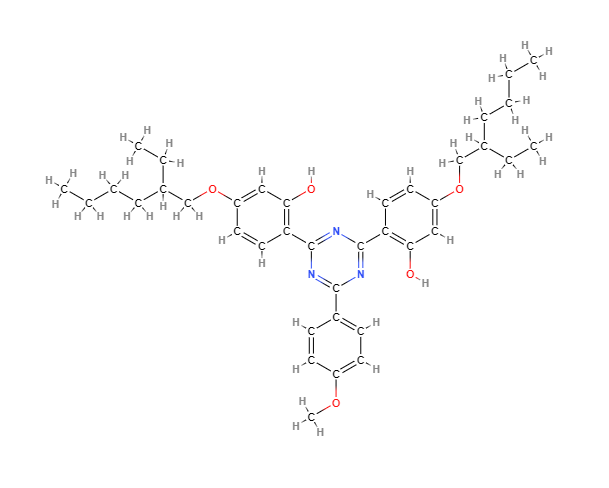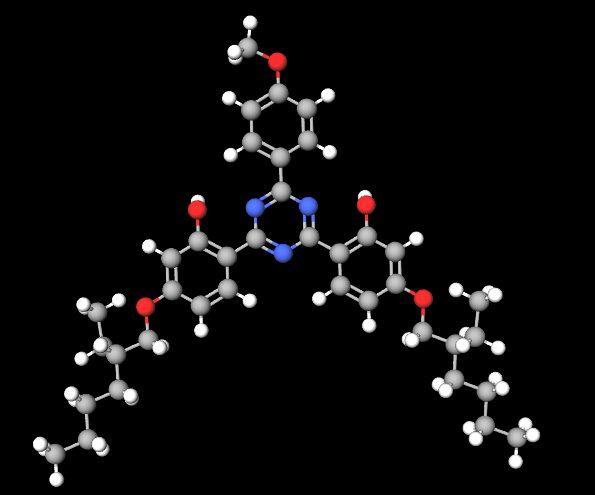![]() Bemotrizinol
Bemotrizinol
Rating : 6
| Evaluation | N. Experts | Evaluation | N. Experts |
|---|---|---|---|
| 1 | 6 | ||
| 2 | 7 | ||
| 3 | 8 | ||
| 4 | 9 | ||
| 5 | 10 |
Cons:
Cosmetics Regulation provisions (1)0 pts from Al222
| Sign up to vote this object, vote his reviews and to contribute to Tiiips.Evaluate | Where is this found? |
| "Descrizione" about Bemotrizinol by Al222 (20707 pt) | 2024-Oct-06 16:14 |
| Read the full Tiiip | (Send your comment) |
Bemotrizinol (Bis-Ethylhexyloxyphenol Methoxyphenyl Triazine) is a highly effective, broad-spectrum organic sunscreen agent. It is primarily used in sunscreens and cosmetic products for its ability to absorb both UVA and UVB radiation, protecting the skin from sun damage and premature aging. Known for its stability under sunlight and its efficiency in providing long-lasting sun protection, this ingredient is widely used in sun care products.
Chemical Composition and Structure
Bis-Ethylhexyloxyphenol Methoxyphenyl Triazine is a triazine-based compound, with phenol and methoxyphenyl groups attached to ethylhexyl chains. This complex chemical structure allows it to absorb a wide range of ultraviolet (UV) radiation, providing broad-spectrum protection. Its structure is specifically designed to remain photostable, meaning it does not degrade when exposed to sunlight, which makes it an excellent choice for durable sun protection.
Physical Properties
This compound typically appears as a pale yellow or white powder, which is oil-soluble and easily incorporated into cosmetic formulations. It is highly resistant to water, sweat, and environmental factors, making it a preferred choice in sunscreens and long-lasting protective products. Its photostability ensures that it maintains its effectiveness for extended periods after application.
The name describes the structure of the molecule:
Bis. This prefix indicates the presence of two similar or identical functional groups in the molecule.
Ethylhexyloxyphenol. This represents an ethyl group attached to a phenol and to ethyl oxide, which is often used as an organic solvent.
Methoxyphenyl. This indicates the presence of a methoxyphenyl group in the molecule, meaning it consists of a phenyl ring attached to a methoxy group.
Triazine. This indicates the basic chemical structure of the molecule, which is a triazine derivative. Triazine is a six-membered aromatic ring containing three nitrogen atoms.
Chemical Industrial Synthesis Process
The production of Bis-Ethylhexyloxyphenol Methoxyphenyl Triazine, a broad-spectrum organic sunscreen agent used in sun protection products for its ability to absorb both UVA and UVB rays, follows a complex chemical process. This compound is also known by the INCI name Bis-Ethylhexyloxyphenol Methoxyphenyl Triazine. Here is a detailed overview of the process.
Synthesis. The synthesis begins with the preparation of chemical precursors, which include ethylhexyloxyphenol and methoxyphenyl triazine. These compounds are synthesized through specific chemical reactions that require catalysts and controlled reaction conditions.
- Condensation. The precursors are then reacted together in a condensation reaction. This step may require the use of acid or base catalysts and strict control of temperature and reaction time to favor the formation of the desired product.
- Purification. After the condensation reaction, the crude product may contain impurities or by-products that need to be removed. Purification is carried out using techniques such as crystallization, vacuum distillation, or chromatography to obtain a pure final product.
- Quality Control. The purified Bis-Ethylhexyloxyphenol Methoxyphenyl Triazine undergoes rigorous quality control checks to verify its purity, chemical structure, and efficacy as a sunscreen agent. These tests can include UV spectroscopy, high-performance liquid chromatography (HPLC), and in vitro efficacy tests.
What it is for and where
Cosmetics - INCI Functions
It is a restricted ingredient as VI/25 a Relevant Item in the Annexes of the European Cosmetics Regulation 1223/2009. Substance or ingredient reported: 2,2'-(6-(4-Methoxyphenyl)-1,3,5-triazine-2,4-diyl)bis(5-((2-ethylhexyl)oxy)phenol) / Bemotrizinol
Maximum concentration in ready for use preparation 10%
Hair conditioning agent. A significant number of ingredients with specific and targeted purposes may co-exist in hair shampoo formulations: cleansers, conditioners, thickeners, matting agents, sequestering agents, fragrances, preservatives, special additives. However, the indispensable ingredients are the cleansers and conditioners as they are necessary and sufficient for hair cleansing and manageability. The others act as commercial and non-essential auxiliaries such as: appearance, fragrance, colouring, etc. Hair conditioning agents have the task of increasing shine, manageability and volume, and reducing static electricity, especially after treatments such as colouring, ironing, waving, drying and brushing. They are, in practice, dispersants that may contain cationic surfactants, thickeners, emollients, polymers. The typology of hair conditioning agents includes: intensive conditioners, instant conditioners, thickening conditioners, drying conditioners. They can perform their task generally accompanied by other different ingredients.
Light stabilizer. It prevents light from degrading light-sensitive components and slows down degradation reactions that have already begun. The mechanism is, in a way, similar to antioxidants and the effectiveness depends on the.complexity of the formulation and the density of the product.
UV absorber. It acts by intercepting ultraviolet light before it can cause damage by reducing its energy through dissipation and returning it to a lower energy state.
UV filter. It is the defining ingredient in sun creams that can mitigate the sun's ultraviolet (UV) radiation, which is a high risk factor for the development of skin cancer, erythema and photo-ageing.
Health and Safety Considerations
Safety in Use
Bis-Ethylhexyloxyphenol Methoxyphenyl Triazine is considered safe for use in cosmetic products and sunscreens. It has been extensively tested and is approved by various regulatory bodies for its effectiveness and safety. It does not penetrate deeply into the skin, remaining on the surface to provide protection without causing irritation or allergic reactions in most users.
Allergic Reactions
Although allergic reactions to this compound are rare, individuals with very sensitive skin or specific allergies to chemical sunscreens should exercise caution. In general, it is well-tolerated by most skin types.
Toxicity and Carcinogenicity
There is no evidence to suggest that Bis-Ethylhexyloxyphenol Methoxyphenyl Triazine is toxic or carcinogenic. It has undergone extensive safety testing and is regarded as a safe and effective UV filter when used in recommended concentrations in sun care products.
Environmental and Safety Considerations
There is ongoing research into the environmental impact of certain chemical UV filters, particularly regarding their effects on marine life and coral reefs. While Bis-Ethylhexyloxyphenol Methoxyphenyl Triazine is considered safe for human use, manufacturers are encouraged to follow environmental guidelines and consider eco-friendly formulations when possible.
Regulatory Status
Bis-Ethylhexyloxyphenol Methoxyphenyl Triazine is approved for use in cosmetic and sunscreen products in many regions, including the European Union, where it is one of the most popular UV filters, as well as in other countries with strict sun care regulations. It is not currently approved by the U.S. Food and Drug Administration (FDA) but is widely used in European, Asian, and other international markets.
Studies
Considered safe for use in cosmetic and sun protection products, following the guidelines and concentration limits established by regulatory authorities (1).
However, cases of allergic contact dermatitis have been reported (2).
 |  |
Molecular Formula C38H49N3O5
Molecular Weight 627.8 g/mol
CAS 187393-00-6
UNII PWZ1720CBH
EC Number 425-950-7 606-111-6
DTXSID40896984
Nikkaji J1.824.435G J3.006.203E
Synonyms
- bemotrizinol
- Tinosorb S
References_____________________________________________________________________
(1) D'Ruiz CD, Plautz JR, Schuetz R, Sanabria C, Hammonds J, Erato C, Klock J, Vollhardt J, Mesaros S. Preliminary clinical pharmacokinetic evaluation of bemotrizinol - A new sunscreen active ingredient being considered for inclusion under FDA's over-the-counter (OTC) sunscreen monograph. Regul Toxicol Pharmacol. 2023 Mar;139:105344. doi: 10.1016/j.yrtph.2023.105344. Epub 2023 Feb 3. PMID: 36738872.
(2) Suzuki K, Futamura K, Sugiyama M, Matsunaga K, Yagami A. Allergic contact dermatitis caused by dimethicodiethylbenzalmalonate (polysilicone-15, Parsol SLX) and bis-ethylhexyloxyphenol methoxyphenyl triazine (Tinosorb S) in sunscreen cream. Contact Dermatitis. 2022 Jul;87(1):108-110. doi: 10.1111/cod.14112. Epub 2022 Apr 11. PMID: 35306675.
| Sign up to vote this object, vote his reviews and to contribute to Tiiips.EvaluateClose | (0 comments) |
Read other Tiiips about this object in __Italiano (1)
Component type: Chemical Main substances:
Last update: 2024-02-23 12:17:56 | Chemical Risk: |


